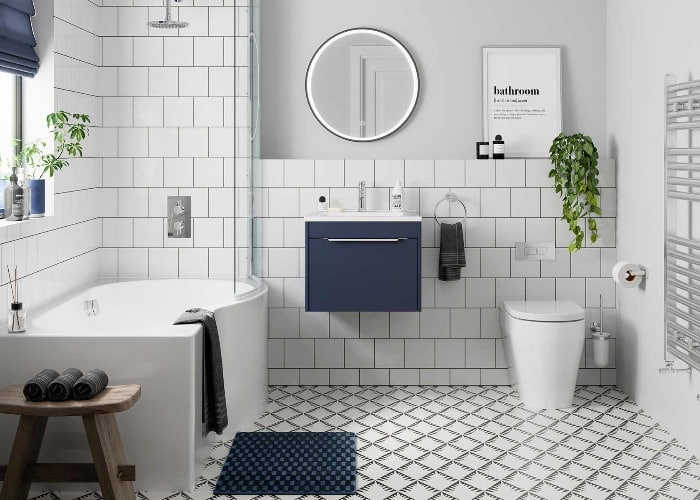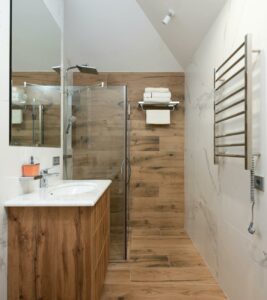Starting a Bathroom Installation Project
Beginning a bathroom installation project is a significant step towards enhancing the functionality and aesthetics of your home. However, it’s essential to understand the reasons behind such a decision and the importance of choosing a reliable contractor to ensure a successful outcome.
Reasons to Install a New Bathroom
There are numerous reasons why a homeowner might decide to install a new bathroom. For some, it may be due to the need for additional space to accommodate a growing family. For others, it could be the desire to upgrade an outdated bathroom and increase the home’s overall value. Additionally, installing a new bathroom can improve the functionality and convenience of the home, especially for households with multiple occupants.
Regardless of your reasons, it’s crucial to plan your project well. Consider your budget, timeline, and the potential disruption to your daily routine. For a comprehensive understanding of the time and cost involved in bathroom fitting, refer to our guide on bathroom fitting: understanding the time and cost involved.
Choosing a Contractor for Your Project
Selecting a trustworthy bathroom installer is critical to the success of your project. A competent contractor will not only deliver high-quality work but also manage the project efficiently, ensuring that it stays within the budget and timeline you’ve set.
When evaluating potential contractors, consider their experience, credentials, and customer feedback. Ask for references and examine their portfolio to assess the quality of their work. It’s also important to conduct interviews to gauge their understanding of your vision and their approach to problem-solving. For more insights on this topic, visit our article on evaluating bathroom fitters: credentials and experience matter.
Be wary of contractors who offer significantly lower prices than their competitors, as this may reflect inferior work quality. Always remember that while cost is a critical factor, it should not compromise the quality of your bathroom installation. To avoid common pitfalls in choosing a contractor, check out our article on mistakes to avoid when choosing a bathroom installer.
Starting a bathroom installation project is a significant undertaking, but with careful planning and the right contractor, it can be a rewarding venture. As you embark on this journey, keep in mind that the goal is to create a space that meets your needs, reflects your personal style, and adds value to your home.
The Bathroom Installation Process
When embarking on a bathroom installation project, understanding the process can help set expectations right and ensure a smoother transition. Here’s what to expect during the bathroom installation process, from consultation and design planning to material selection and understanding the installation timeline.
Initial Consultation and Design Planning
The initial consultation with your bathroom installer is a crucial step where you share your vision and ideas for your new bathroom. An experienced installer will help you with design planning, advising on the layout, functionality, and aesthetic elements that suit your preferences and the existing architecture of your home. Decisions made during this phase largely affect the subsequent steps, so it’s essential to be clear about what you want. For more guidance on this, consider visiting our article on finding the right bathroom installer: what to look for.
Selecting Materials and Fixtures
After finalizing the design, the next step is selecting the materials and fixtures for your bathroom. This includes everything from tiles, countertops, and cabinets to faucets, lighting, and other fixtures. The choice of materials not only influences the look and feel of your bathroom but also impacts the project’s cost and timeline. Your installer can provide valuable input on the best materials to use based on your budget, design plan, and durability requirements. For more insights on this, you may refer to our guide on the complete guide to professional bathroom fitting services.
The Installation Timeline
The timeline for a bathroom installation can vary widely depending on the project’s complexity, the materials chosen, and the installer’s schedule. A simple bathroom remodel might take a few days, while a complete bathroom installation could take several weeks. Your installer should provide a detailed timeline, including the start and expected completion dates and milestones along the way. This will help you plan your life around the installation and manage expectations. For more on this, check out our article on bathroom fitting: understanding the time and cost involved.
Understanding the bathroom installation process can make the journey less stressful and more exciting. Always remember that communication with your installer is key to ensuring a successful project. Don’t hesitate to ask questions or voice concerns at any stage of the process. For more insights on what to expect during the bathroom installation process, visit our article on common challenges in bathroom installation and how to overcome them.
What to Expect During the Installation
Understanding what to expect during the bathroom installation process can help homeowners prepare for their renovation project. From the initial stages of installation to potential challenges, here’s what you need to know.
Stages of Bathroom Installation
The process of bathroom installation typically involves several stages.
- Demolition and Removal: The first step involves removing the existing fixtures, tile, and drywall. This stage can be messy and noisy, so it’s important to prepare your home accordingly.
- Plumbing and Electrical Work: Once the old bathroom has been removed, the plumber and electrician will install new pipes and wiring.
- Floor and Wall Installation: The next step is to install the flooring and wall coverings. This may include tile, paint, or wallpaper.
- Fixture Installation: The final stage involves installing the new fixtures, such as the bathtub, sink, toilet, and lighting.
Each stage of the installation process requires careful planning and execution. Homeowners should maintain open lines of communication with their bathroom installers & fitters to ensure the project stays on track.
Potential Challenges and How to Overcome Them
Like any home renovation project, bathroom installation can come with its own set of challenges. These may include unexpected plumbing issues, delays in material delivery, or changes to the original design plan. It’s important for homeowners to remain flexible and patient throughout the process.
One common challenge is dealing with unexpected plumbing or electrical issues. Older homes, in particular, may have outdated systems that need to be upgraded. In this case, it’s important to work with a qualified contractor who can address these issues safely and efficiently.
Delays in material delivery can also cause setbacks. To avoid this, try to order all materials well in advance of the start date.
Lastly, changes to the original design plan can lead to increased costs and extended timelines. To minimize this risk, spend plenty of time planning your bathroom design before the installation begins.
Despite these potential challenges, a bathroom installation can be a rewarding project with a beautiful end result. For more tips on how to navigate through potential setbacks, check out our article on common challenges in bathroom installation and how to overcome them.
Remember, a solid understanding of what to expect during the bathroom installation process can help make your renovation project go as smoothly as possible.
Living Through a Bathroom Installation
Enduring a bathroom installation process can be daunting, but with the right preparation and planning, it can be a manageable experience. This section will guide you on how to prepare your home for the installation and maintain your daily life during the process.
Preparing Your Home for the Installation
Before the bathroom installers arrive, there are several steps homeowners can take to prepare their space for the installation process. Here’s a handy checklist:
- Clear out the bathroom: Remove all personal items, toiletries, and decorations from the bathroom. Not only does this protect your belongings, but it also gives the installers a clean slate to work with.
- Create a workspace: Allocate a space for the installers to store their tools and equipment. This could be a garage or a spare room.
- Protect your home: Cover the floor leading to the bathroom with a protective material to prevent damage. You can also move any furniture or fragile items that are in the pathway.
- Discuss the plan: Ensure you understand the installation plan. Knowing what work will be done each day can help you better manage your household activities during the process. For more information, you can read our guide on what to expect during the bathroom installation process.
Maintaining Daily Life During the Process
Living in a home undergoing a bathroom installation can undoubtedly disrupt daily routines. Here’s how you can minimize the impact:
- Plan for limited access: Your bathroom will likely be inaccessible for a portion of the installation. Plan for this by adjusting schedules or making arrangements to use a different bathroom.
- Be flexible: Delays can occur during the installation process. Be prepared to adapt your plans if necessary.
- Communicate with the installers: Keep the lines of communication open with your bathroom installers & fitters. If you have concerns or questions, don’t hesitate to ask.
- Stay out of the work area: For safety reasons, it’s best to avoid the work area when the installers are present.
Remember, a bathroom installation is temporary but the results will be enjoyed for years to come. For more in-depth guidance on bathroom installations, check out our complete guide to professional bathroom fitting services.
Post Installation: What’s Next?
After the completion of your bathroom installation, there are a few more steps to take to ensure the longevity and functionality of your newly installed bathroom. This involves checking the quality of the installation work and knowing the necessary care and maintenance tips.
Ensuring the Quality of Installation Work
Once the bathroom installation is complete, it’s important to ensure the quality of the work done. Start by inspecting the bathroom thoroughly, checking for any imperfections or issues. Look at the plumbing fixtures, the tiling, the paint, and all the other elements that were part of the project. If there are any issues, it’s crucial to address them as soon as possible with your contractor.
Remember, a reputable bathroom installer will guarantee their work and address any issues promptly. Refer to our guide on finding the right bathroom installer: what to look for and evaluating bathroom fitters: credentials and experience matter to ensure you’ve hired a reliable professional.
Finally, ask your contractor to walk you through the work they’ve done. This is an opportunity to ask any questions and understand the specifics of your new fixtures and features. Refer to our article on essential questions to ask before hiring bathroom fitters for some ideas on what to ask.
Care and Maintenance Tips for Your New Bathroom
Maintaining your new bathroom is key to making it last and keeping it looking its best. Here are some basic care and maintenance tips:
- Clean regularly: Regular cleaning can prevent build-up of soap scum and mildew, keeping your bathroom looking fresh and new.
- Ventilate: Proper ventilation is crucial in preventing moisture build-up, which can lead to mold and mildew. Make sure to use your bathroom fan or open a window when bathing or showering.
- Be gentle: Avoid using harsh chemicals or abrasive cleaning tools that could damage your fixtures or surfaces.
- Inspect frequently: Regularly check your bathroom for any signs of leaks, damage, or wear. Early detection can prevent more serious issues down the line.
For more detailed tips on maintaining your new bathroom, check out our article on post-installation care: tips from bathroom fitting experts.
Taking the time to ensure the quality of the installation work and learning how to properly care for your new bathroom can ensure that your installation project is a success. Remember, your bathroom is an investment in your home, and it’s worth taking the time to make sure it’s done right.




